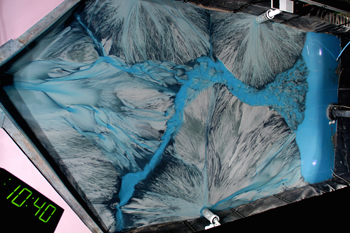Decoupling allogenic forcing from autogenic processes:
Experimental
geomorphology and stratigraphy
By:
Dr. Wonsuck Kim
UT Institute for Geophysics
| When: | Friday, April 22, 2011, 10:30 p.m. to 11:30 p.m. |
| Where: | Seminar Conference Room, 10100 Burnet Road, Bldg 196-ROC, Austin, Texas 78758 |
| Host: | Charles Jackson, UTIG |

Abstract
At the heart of interpreting the evolution of the Earth's surface
preserved in the sedimentary record is decoupling the preserved signal of
environmental (allogenic) forcing from those of internally generated
(autogenic) processes. A major stumbling block for distinguishing allogenic
versus autogenic signatures in the stratigraphic record is a lack of
quantitative understanding of autogenic processes and their interactions
with allogenic forcing. Physical experiments with moving sediment and water
construct topography with dynamic self-organized fluvial system, thus
providing an opportunity to investigate autogenic processes under controlled
boundary conditions (e.g., sediment supply and tectonics).
This presentation
reviews a set of tank experiments that are used to quantitatively examine 1)
the autocyclic storage and release of sediment in the deltaic surface
associated with river-pattern changes between channel and sheet flow, and 2)
changes in fluvial autocyclic behavior driven by external forcing (e.g.,
sea-level change and tectonics). The time and event scales of the autogenic
processes observed in the experiments conducted without external forcing
provided the first-order quantitative understanding of the autogenic
processes.
Changes in the frequency of autogenic processes due to base-level
change and lateral ground tilting provided a new view to the coupled
allogenic and autogenic control on stratigraphic development. Coupled
experiments that test the effect allogenic forcing on autogenic process are
presented here: one conducted with constant external forcing and the other
with cyclic changes in external controls.
This review provides 1)
quantitative measurements of fluvial autogenic processes and thorough
comparisons of cyclic strata attributed to allogenic versus autogenic
controls, and 2) suggestions of future directions on experimental study of
fluvial autogenic processes that will enhance our ability to interpret the
mixed signals of environmental variation and internal dynamics in the
sedimentary record.




